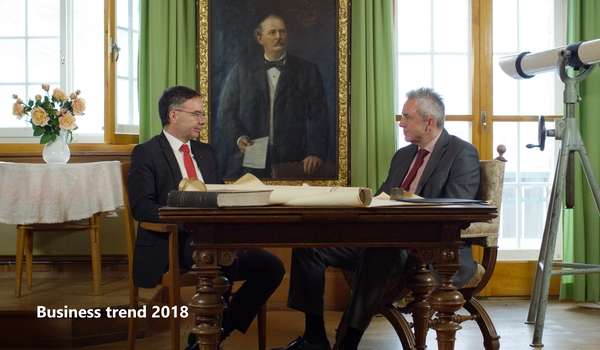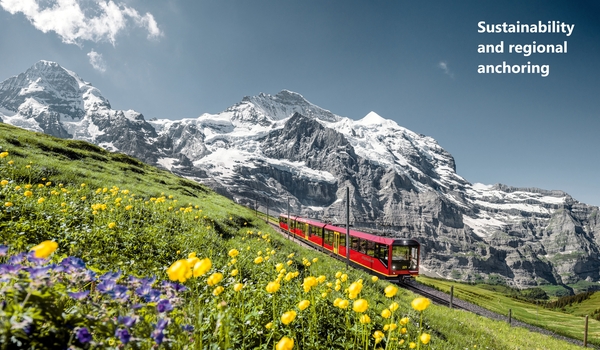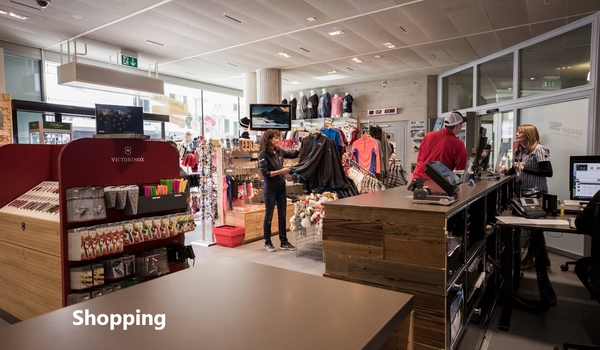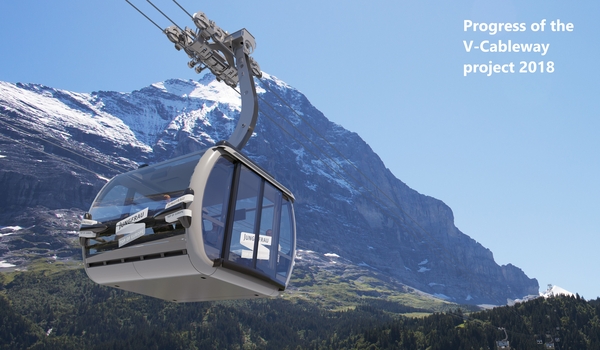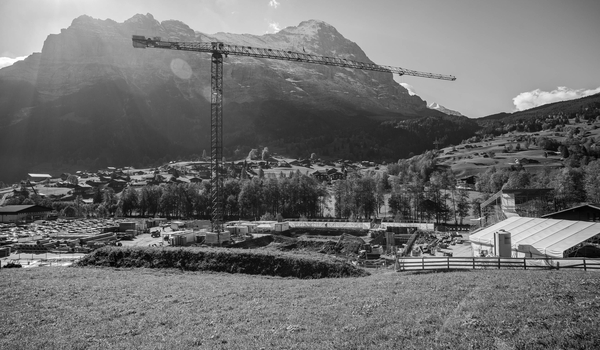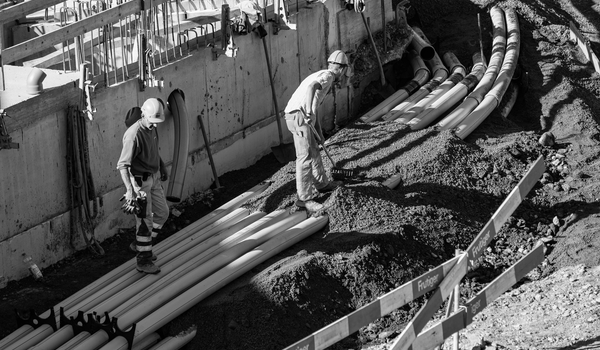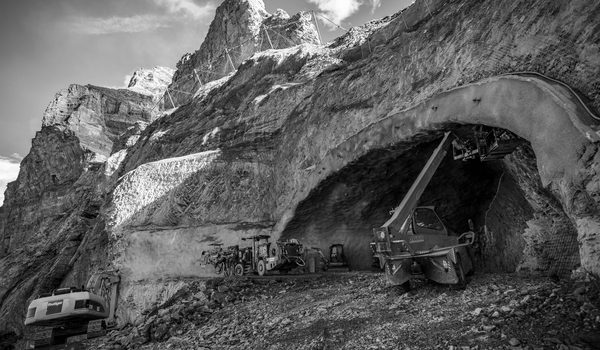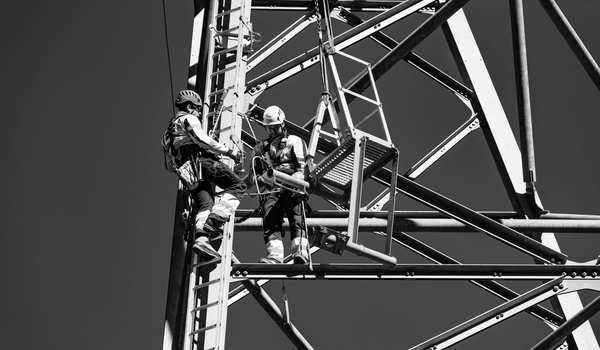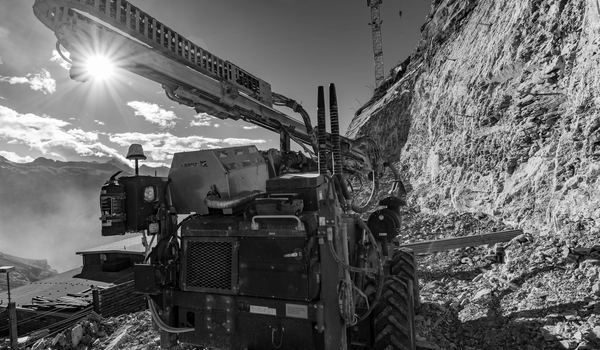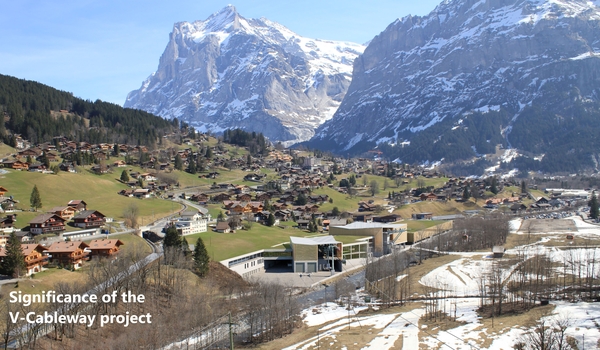Welcoming address to the shareholders
Dear Shareholders
Green light for the V-Cableway! The joy and relief were palpable when the decision of the Federal Office of Transport became final on 9 June 2018. At the end of May, we received the concessions and planning permission for the “Eigerexpress” tricable gondola lift, for the ten-person gondola Grindelwald-Männlichen, for the “Grindelwald Terminal” railway station, the conversion and expansion of the Eigergletscher railway station and the new parking garage. The additionally necessary decrees from the government officials of Interlaken-Oberhasli and the canton of Bern for zone adjustments, bridges, runways, etc. were also in place. Now the last remaining opponents have announced that they would waive their objection against the construction of the V-Cableway. After years of clarifications, the examination of variants and sub-variants, exhausting political disputes and a huge preliminary planning work, the construction work on the core elements of the V-Cableway could finally start on 11 June 2018.
Prof. Dr. Thomas Bieger, Chairman of the Management Board and Urs Kessler, Chief Executive Officer
The Grund-Eiger Glacier Eigerexpress and the new Männlichen Railway, the main facility of our partner company Gondelbahn Grindelwald-Männlichen AG, form the “V”, which gave the entire project the name “V-Cableway”. The two high-performance cable cars will start out in the new Grindelwald Terminal tourist hub with shops, restaurants, a 1000-storey car park and direct connection to the network of the Bernese Oberland Railway. With a total investment of CHF 470 million (Jungfrau Railway Group CHF 320 million), we will be able to position the Jungfraujoch – Top of Europe and its surroundings as one of the most important mountain railway attractions and the most sought-after tourist and leisure brands in the world for generations to come. This fills us with pride and confidence. We will do everything we can to open the Männlichen Railway and station on 14 December 2019 as well as the Eigerexpress and the parking garage on 12 December 2020.
The V-Cableway project also includes major renovations in the rolling stock of the railways, which have already been implemented. Within the Group, the Eigerexpress creates valuable synergies by providing answers to strategic problems in the winter sports segment, in addition to the advantages for the Jungfraujoch. It is not only Jungfraujoch customers who will reach their destination more quickly. For winter sports enthusiasts, long waiting times in the valley will be a thing of the past. Journeys will be faster and more convenient. Skiers and snowboarders can enjoy the attractive descents into the valley every day. Increased attractiveness and excellent service with the best terminal in the Alps is the only permanent answer to the challenges in the highly competitive winter sports market.
The financial year 2018 was very successful. We achieved new visitor frequency and turnover records on the Jungfrau Railway, the Harder Railway, the Mürren Railway and the First Railway, and again more than one million guests visited Jungfraujoch – Top of Europe. In the Jungfraujoch – Top of Europe segment, this resulted in a net transport income of CHF 111.8 million with an average yield per guest of 1.8 per cent. Total sales grew for the first time to over CHF 200 million. The extremely pleasing group result for 2018 is CHF 47.8 million.
Business success raises the bar for future years. We are challenged to meet the constant high expectations of our company without unbearably burdening the environment and thereby reducing the genuine nature experience for our customers. In this context, we also see the new V-Cableway as an opportunity: In the future, we will be able to offer passengers greater ride comfort in less time and more flexibility in route selection. This will trigger individual, more flexible travel behaviour for the visitor and will thus open up new possibilities for smart guest guidance.
Overcrowding as well as traffic jams will be reduced and the capacity better utilised. Better utilisation of transport opens up prospects of increasing the annual number of visitors without straining the natural limits of sustainable use of the environment. From an environmental perspective, the success of this strategy is monitored, among other things, by the management of the UNESCO World Heritage Swiss Alps Jungfrau-Aletsch. A positive factor for future generations will also be that the V-Cableway will promote the use of public transport by connecting to the railway network. The overall project thus secures the long-term competitiveness of the region and the income of the population. The commitment to Lauterbrunnen and Grindelwald is backed up by a sustainability fund set up at the time of opening of the entire V-Cableway.
Our vision of sustainable development and the constant increase in convenience – which is essential for securing the price level – result in qualitative growth targets that continue to put our innovative strength to the test. New digital processes help us to accomplish these tasks. The projects are being driven forward by our innovative teams along with their trusted partners for the completion of the V-Cableway. In the design of integrated tourist offers and services, we have always been one of the first movers. At the start of the decade, we focused on bundling all tourism services into one digital shopping cart. We can take advantage of our experience in networking the most diverse partners and products. We will show the V-Cableway customers their own individual way of experiencing and enjoying the entire tourism service chain.
In our online annual report, in addition to the management report and our figures, we would like to show you the added value of the V-Cableway for the regional environment and its tourism partners, and – crucially – the benefits for our guests. Our report goes by the motto: “anticipation!” The construction of the V-Cableway underlines our role as the engine of the regional tourism industry. As a major employer and investor, we create value for our immediate environment. This in turn strengthens our regional roots, our Swissness and our international appeal.
Our business models are geared towards the needs of a national and international clientele searching for a unique mountain experience. With global appeal, we are perceived as a worthwhile destination. Thanks to our regional roots, we can meet the expectations of this clientele.
As an integrated tourism company, in keeping with our vision, we want to develop into a leisure company. Accordingly, we have expanded our activities along the value chain. On the Interlaken-Jungfraujoch intersection, the V-Cableway creates a route that complements the excursion and leisure offer with shopping and gastronomy from a single source. We are already operating the catering on Kleine Scheidegg by ourselves as a pilot operation. Further operations at Jungfraujoch and the new V-Cableway terminal in Grindelwald are to follow. In Interlaken, we have successfully tested the interplay of a travel information office, sales point and leisure shop. In 2019, this shopping and information zone will be expanded into a special “flagship store” as a starting point for the Jungfrau – Top of Europe experience.
The feedback from the markets and the reservation levels make us confident about the outlook for 2019. However, our experience from the past has also shown that the worldwide sale of a tourist offer can sometimes encounter unexpected obstacles. Terror attacks, political turmoil or economic turbulence affect the behaviour of international customers. Within the industry, price wars – primarily in China – continue to be relentless. We are concerned about the expansion of the direct travel flat rate offers in the tourism sector. The current trend has a distorting effect on competition and jeopardises the long-term balance of the tariff structure across Switzerland. The Jungfrau Railway Group is making this undesirable economic development public together with partner railways and is supporting the corrective efforts here. In our message, informing you of opportunities and risks, we will once again delve deeper into this complex but no less important topic.
We would like to take this opportunity to thank our employees for the outstanding performance and their daily, genuine hospitality towards our customers. We also thank our customers, the federal and cantonal authorities, the municipalities, the mountain communities, the tourism organisations, the neighbouring railways, the resellers, the suppliers, the International Hochalpine Research Station Foundation and all the other partners such as the hotel industry, with whom we should cultivate a fruitful collaboration. Finally, we would like to thank you, dear shareholders, for the trust in our Group and the loyalty you have shown to Jungfraubahn Holding AG.
|
|
|
|
Prof. Dr. Thomas Bieger |
Urs Kessler |
Jungfraubahn Holding AG in brief
Activities of the Jungfrau Railway Group
The Jungfrau Railway Group is a leading tourism company and the largest mountain railway company in Switzerland. The most important offer is the journey on the spectacular railway to Jungfraujoch – Top of Europe, 3,454 metres above sea level. In the Asian markets, due to the development of the first distribution and agency network, it has achieved a leading position when it comes to visiting the glacier world of the Alps. The Jungfrau Railway Group also operates mountain railways on well-known Experience Mountains in the Jungfrau Region, winter sports facilities, a hydroelectric power station, restaurants, shops and parking facilities.
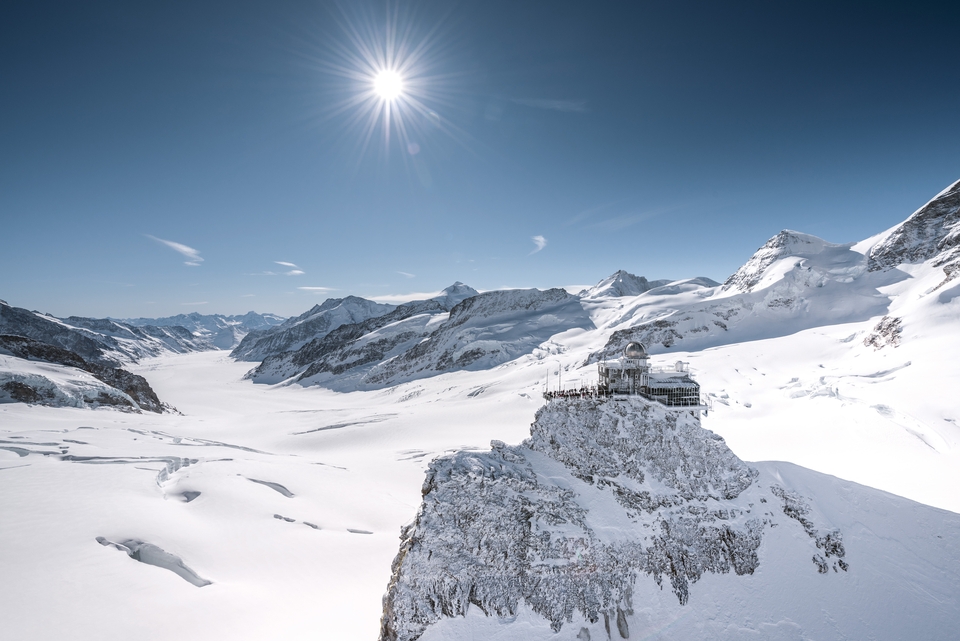
Sphinx and Aletsch Glacier
Focus on the customer is an element of sustainable orientation above all other guiding principles. The Group thus achieves an attractive positioning on the market for tourists and investors. We represent a significant regional economic factor and play a leading role in the tourism sector. In cooperation with other tourism companies, we promote the further development of the Jungfrau Region.
Operating income
Operating result (EBIT)
Annual profit
Number of personnel
Goals of the Jungfrau Railway Group
As the leading tourism company in Switzerland and the largest mountain railway group, the Jungfrau Railways Group is developing as an integrated leisure and service company. At the same time, it focuses on
- its entrepreneurial tradition of more than 120 years,
- with the vision of its founder to make the unique Alpine landscape accessible to the wider population and international tourists,
- its sound foundation in the Jungfrau Region,
- its brand, service and technical competence developed over generations
It is the driving force behind the economic development of the Jungfrau Region and alpine tourism in Switzerland. It thus makes a significant contribution to the strengthening of this region. It takes into account the interests of the region and its residents, encourages its employees and looks after nature, which is an important resource for the development of the region as well as Jungfrau Railways. It should be preserved and accessible to future generations in keeping with the founder's vision. A prerequisite for this is to maintain economic independence and increase attractiveness for investors. The Jungfrau Railways Group attaches great importance to sustainability.
The objective is to strengthen the Jungfraujoch – Top of Europe as the main source of revenue. Internal growth is targeted through better utilisation of the off-season, moderate increase in transport capacities as well as through the integration of further services such as shopping, catering and soft adventure into the adventure chain. The V-Cableway project with the two new cableways and further integrated components (rolling stock renewals, public transport, car park, slope construction etc.) will secure the successful tourist future of the entire Jungfrau Region in the medium term as a top year-round destination for Swiss tourism. Primarily by shortening travel times and increasing travel comfort, the project strengthens the competitiveness of the Jungfraujoch as a beacon known worldwide, and it helps the winter sports destination reach the top position in international competition. The construction work on the new ten-person gondola Männlichen (opening 14 December 2019) and the new Eigerexpress tricable gondola (opening 12 December 2020) could be started on 11 June 2018.
The strategic financial objectives of the Group reflect the orientation towards long-term goals and the policy of a value-based company (value stock). The key factors determining the financial planning of the Group are earnings targets and free cash flow targets. You can take this from our financial report.
Business segments of the Jungfrau Railway Group
Jungfraujoch – Top of Europe
The Jungfraujoch – Top of Europe is the most profitable segment of the Group. The core of this segment is the highest railway station in Europe at 3,454 metres above sea level, situated within the UNESCO World Heritage Site SWISS ALPS Jungfrau-Aletsch. The marketing of the trip with the Wengernalp Railway and the Jungfrau Railway to the Jungfraujoch – Top of Europe is the strategic heart of the company. In 2018, a new visitor record was achieved with 1,067,000 guests. After 2015 and 2017, the Top of Europe exceeded the magic mark of one million visitors for the third time.
Jungfraujoch visitors
Winter Sports
The winter sport facilities in the areas Kleine Scheidegg-Männlichen, Grindelwald-First and Mürren-Schilthorn are part of the JUNGFRAU Ski Region subscriber association, in which the Jungfrau Railway Group, because of the facilities it owns and operates, holds a share of over 60%. Together with the partner companies, the Group leads one of the most important ski resorts in Switzerland on behalf of the association.
JUNGFRAU Ski Region guest visits
Experience Mountains
The Experience Mountains segment includes destinations in the surrounding area of the Jungfraujoch – Top of Europe: Grindelwald-First – Top of Adventure, Harder Kulm – Top of Interlaken, and Winteregg-Mürren – Top of Family. These destinations enhance the regional experience and allow for interesting combinations such as holiday passes and cross marketing.
Sales by segment
The amount of net sales provides information on the size of the business segments. “Other segments” comprise a wide range of services that support the business of the main segments internally and are also used by external customers. These include, for example, Jungfraubahnen Management AG, the power plant and the car park in Lauterbrunnen. The following compilation also includes the internal Group eliminations.
The holding company
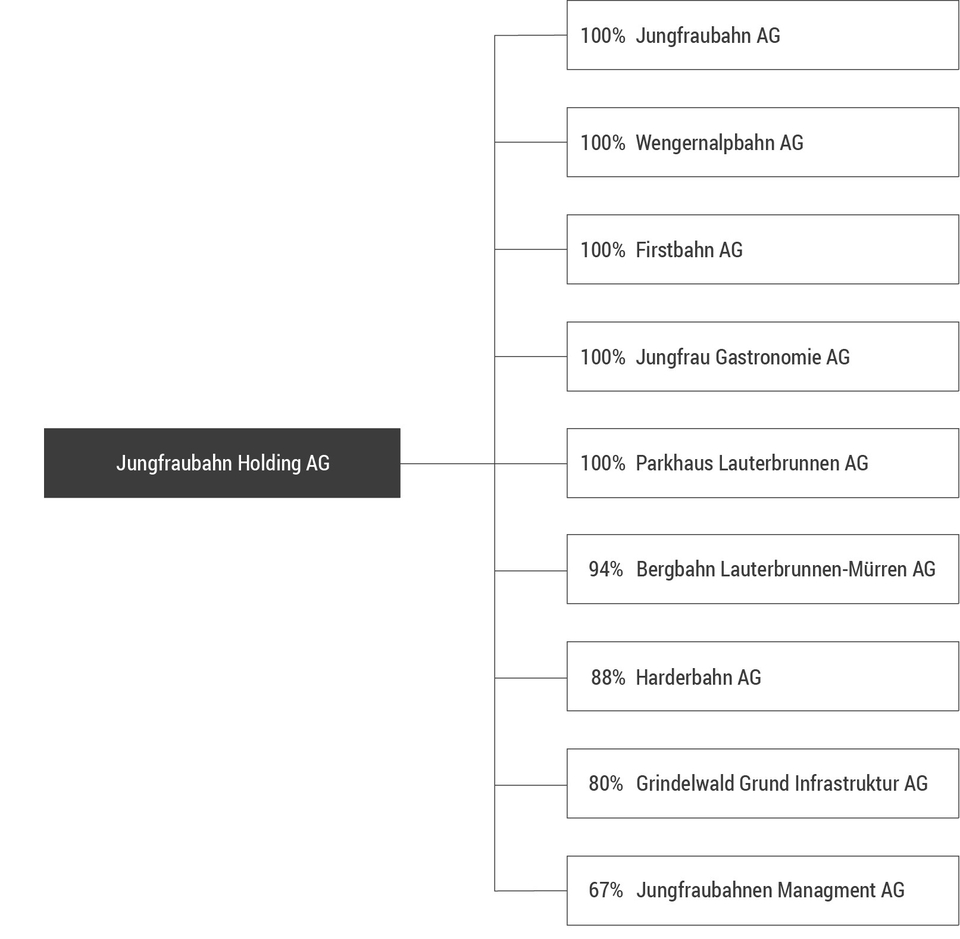
Operating subsidiaries of the Group
Organisation
The Management Board of Jungfraubahn Holding AG is the top decision-making body of the Group. It is responsible for strategic planning for the entire Group and implements this within the scope of its legal and factual capacities at the subsidiaries. The Executive Board of the Jungfrau Railways Group is appointed in accordance with the provisions of the Management Board of Jungfraubahn Holding AG and in a framework approved by the general meeting of Jungfraubahn Holding AG for the total compensation by Jungfraubahnen Management AG.
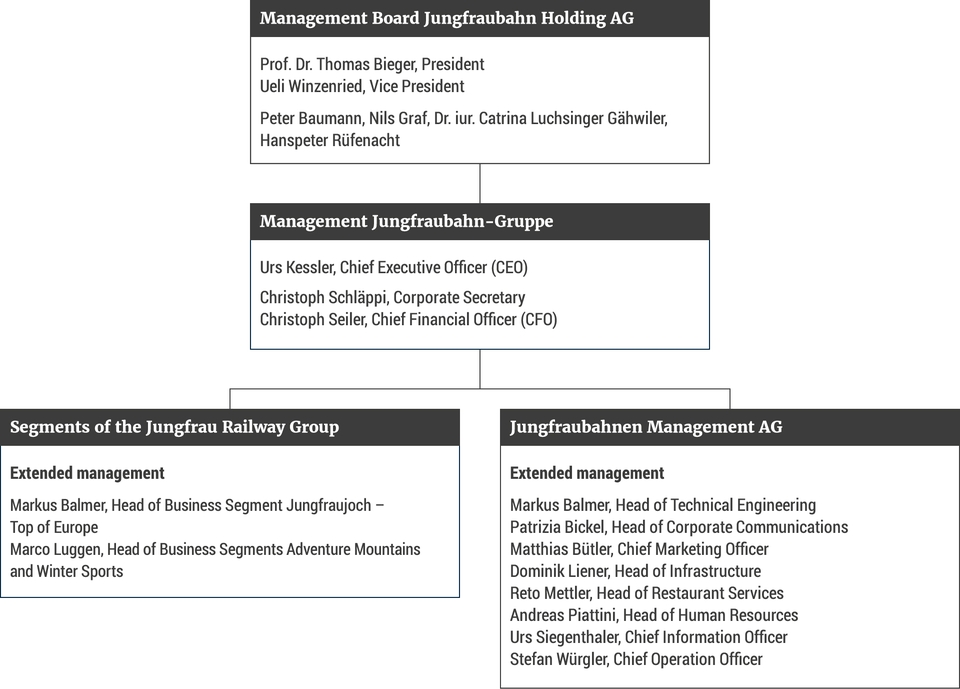
The information on the staffing of the bodies is updated at the time of the drafting of the annual report (end of March 2019). Details and information on changes during the year 2018 can be found in the special points/personnel chapter and the corporate governance report.
Key figures of the consolidated financial statements
| CHF (thousands) | 2018 | 2017 | Change in per cent |
|---|---|---|---|
| Operating income | 212,815 | 193,770 | 9.8% |
| Transportation revenues | 153,833 | 143,799 | 7.0% |
| EBITDA | 95,111 | 87,743 | 8.4% |
| EBITDA in % of operating income | 44.7% | 45.3% | -1.3% |
| EBIT | 60,969 | 53,038 | 15.0% |
| EBIT in % of operating income | 28.6% | 27.4% | 4.4% |
| Annual profit | 47,826 | 41,601 | 15.0% |
| Return on sales (ROS) | 22.5% | 21.5% | 4.7% |
| Free cash flow | 16,305 | 33,837 | -51.8% |
| Equity ratio | 79.7% | 81.6% | -2.3% |
| Headcount (full-time positions) | 600 | 542 | 10.7% |
Jungfraubahn Holding AG (parent company)
Jungfraubahn Holding AG is a holding company. Its business model is characterised by fiscal and financial policy considerations. The most important part of a profit plan is the financial statement. This includes the dividend payments of the subsidiaries and the internal interest income.
The investment income for 2018 amounts to CHF 16.6 million. The loans to the subsidiaries of CHF 101.7 million are subject to an interest rate of 1.0%. Together with the remaining financial income and the offsetting of the financial expenses, the financial statement closes at CHF 17.6 million. Earnings amount to CHF 16.7 million. The detailed financial statements with appendix can be found after the consolidated financial statements in the financial report. It is part of the authorisation request to the 2019 Annual General Meeting.
Jungfrau Railways
The subsidiaries of Jungfraubahn Holding AG (JBH) cooperate closely with Berner Oberland-Bahnen AG (BOB). The cooperation is ensured by Jungfraubahnen Management AG (shares: JBH 67%, Berner Oberland-Bahnen AG 33%). The operating consortium benefits in particular from synergies in the area of management (joint Executive Board, similar management processes, optimal personnel use), marketing, information technology, railway and power engineering. Collectively, the companies involved act under the name “Jungfrau Railways” and under the registered trade mark “Jungfrau – Top of Europe”. Berner Oberland-Bahnen AG transferred its management to Jungfraubahnen Management AG under the terms of the mandate. This mandate is conducted in compliance with the interests of BOB and its independence in accordance with the requirements of the BOB Board of Directors and the regulations of the organisational regulations of Berner Oberland-Bahnen AG.
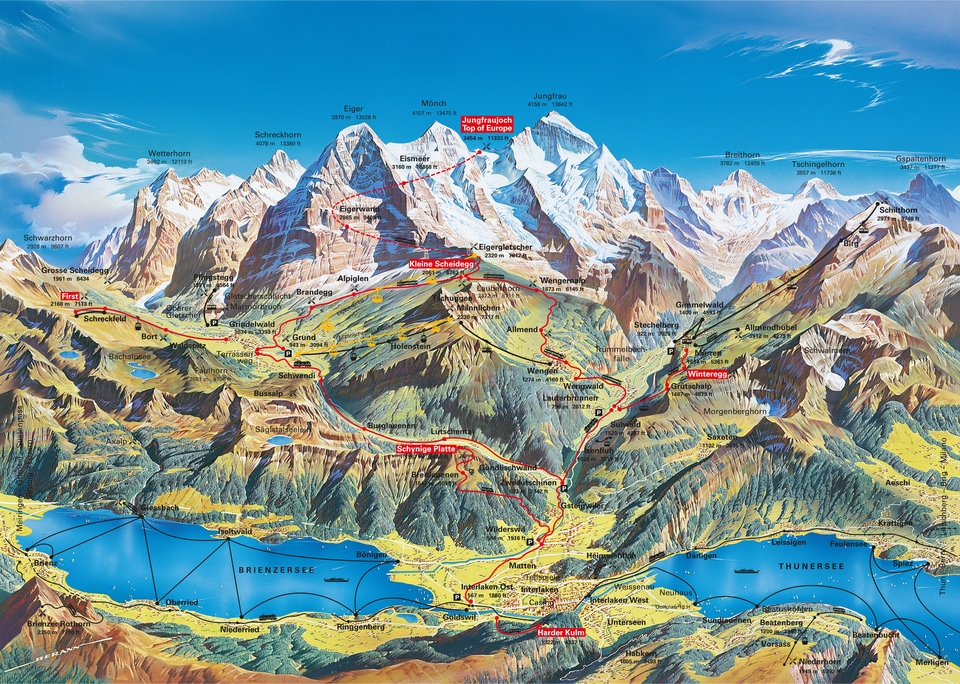
Jungfrau Railways routes in red
Message from company management
Opportunities and risks
The Jungfrau Railway was built at the turn of the 20th century. Since its inauguration on 1 August 1912, the highest railway station in Europe has been located on the Jungfraujoch, at 3,454 metres above sea level – Top of Europe. Due to the unique mountain scenery of the Eiger, Mönch and Jungfrau as well as the touching construction history involving railway pioneer Adolf Guyer-Zeller, the journey on the Jungfrau Railway is a unique attraction in the Alps with a worldwide appeal.
The consistently high demand for tourism forms the basis for the global positioning and marketing of the Jungfraujoch – Top of Europe. UNWTO, the tourism organisation of the United Nations, puts the worldwide growth in arrivals at 6% in 2018. This is only a very slight decline on last year's record growth. The UNWTO also expects further growth of 3 to 4% for 2019. Viewed historically, with this somewhat more moderate rate, tourism is moving in a positive trend [10].
Arrivals in Switzerland increased by 3.7% in 2018 [11]. By contrast, visitor numbers from Asia are showing a positive trend and an above-average figure of more than 10% coming from the USA to Switzerland. In the field of individual travellers, this market is one of the most important for the Jungfrau Railway. India is an important market for the Jungfraujoch that has also developed positively with an increase of 10%. The number of visitors to the Jungfraujoch has responded to this development in demand potential. The number of visitors from the previous year grew by 2.4%. In 2018, for the third time more than one million guests visited the highest railway station in Europe. The study over several years shows that the Jungfrau Railway has been able to disproportionately tap into the potential of international tourists staying in Switzerland.
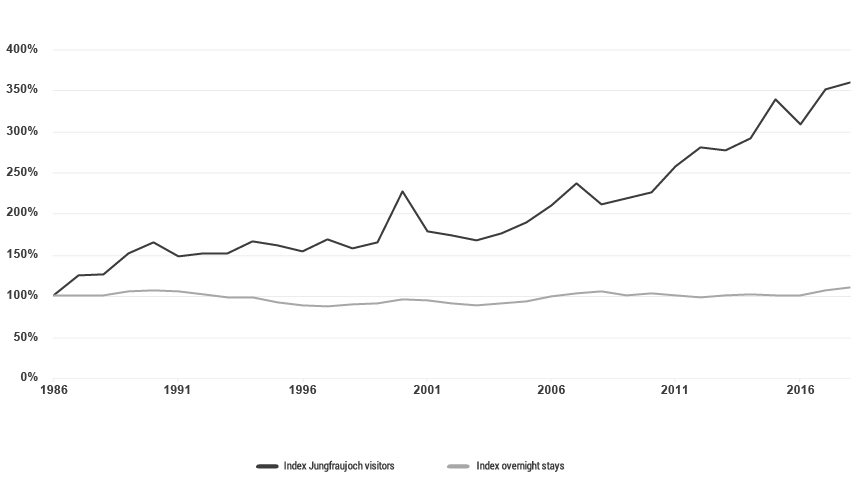
Benchmark for Jungfraujoch visitors and overnight stays for Switzerland indexed
As a pioneer on the Asian markets, the Jungfrau Railways Group already recognised the potential of Asia decades ago. The entire Jungfrau Region also benefited from this. Today, the broad anchorage in Germany, in Europe and in various countries and economic areas in Asia protects against excessive demand fluctuations (volatility of the tourism industry). In addition to the growth markets of China and India, other pillars such as Japan and Korea as well as South East Asia in general are having a stabilising effect. The variety of offers from the Jungfrau Railway Group increasingly plays a balancing role. With the Experience Mountains, the complementary segment in the summer business, customers with a smaller travel budget can be targeted or the excursion to the Jungfraujoch can be meaningfully supplemented in the context of an extended stay (cross-marketing). The Experience Mountains also achieved record results in 2018, which is attributable to a significant increase in demand among young international guests and families from all over the world. By designing the experience with gentle adventure offers, through a special furnishing of the outdoor space with, for example, adventure paths that are easily accessible and walkable without special physical skills, a special vantage platform or a well-maintained playground, the offer manages to meet the needs of these guests. At the centre of this service are employees who maintain and clean the facilities, provide instruction and help in an emergency. New jobs in direct customer service are created as a basis and opportunity for a region that is also lively in the summer with hospitable charm. In recent years, the First Railway has thereby created 15 new jobs in the field of Soft Adventure.
In the strategic risk analysis, the opportunities arising from the unique position of the Jungfraujoch and the special reputation of Switzerland and the hospitable charm of the localities contrast with the risks typical of the tourism business. Demand is dependent on currency fluctuations, geopolitical security and terror threats. Long-lasting bad weather and major storms diminish the turnover, whereas good weather periods increase it.
Due to overcapacity in its own ranks, driven by a subsidy policy in all Alpine regions and the global offer of alternative leisure facilities, the mountain railway industry is facing increasing price pressure. We are concerned about the expansion of the direct travel flat rate offers in the tourism sector. The General Abonnement (GA) and Half-Fare Card are a Swiss achievement. However, the traffic revenues generated from the flat-rate subscriptions and other income of transport companies are not enough to finance the broad public transport supply in its entirety. To this end, the system relies on compensation from the federal government and the canton. In contrast, touristic excursion traffic works differently, at least so far. This is based on revenue models that cover their costs and are often even profitable. By joining mountain railways to the Swiss Travel Pass tourist package subscription, these revenue models become seriously competitive, however. An initial attempt by the industry to correct this threatening market distortion in an immediate and straightforward manner was thwarted by the Federal Office of Transport due to an unexpected interference in the fare autonomy of the transport companies. The Jungfrau Railway Group is pursuing a dual strategy in this situation: It supports direct transport in the efforts to regain fare autonomy in court or by negotiation and then to implement a solution with economic autonomy and independence of the mountain railways. On the other hand, it makes an application for membership of the flat-rate subscription together with the requirement that it be granted a share of the revenue pool proportionate to its position and performance in the international market. In doing so, we are ensuring that the Jungfrau Railway is not sidelined on a tariff basis, despite the uncertain outcome of the current transport policy discussions.
The time required or time loss is an important quality factor in the modern tourism industry. Experienced travellers appreciate long transfers without any experience value as little as skiers appreciate long queues in front of the valley station where they will spend a valuable part of their skiing holiday. Speed, capacities and optimum utilisation are therefore among the production factors that represent a weakness of the mountain railways from the pioneer days. The Jungfrau Railways Group is paying particular attention to this area. Ongoing improvements could be achieved, for example, by more powerful traction units, by track upgrades on the Wengernalp Railway or by a sophisticated reservation system on the Jungfrau Railway. Another advantage in terms of comfort is the realization of the V-Cableway. This major project will secure the medium- and long-term successful future of tourism throughout the entire Jungfrau Region as a vital year-round destination in Swiss tourism. This project is presented separately in detail in the management report.
The Jungfrau Railway Group becomes an integrated leisure and service company
In order to protect itself against the volatility of the tourism industry, Jungfraubahn Holding AG has developed particular strengths: this is based on the high level of self-financing amounting to 79.7%. The financing of the ongoing major investment in the V-Cableway is designed and planned in such a way that this value will only temporarily decrease by a maximum of 10 percentage points. In addition to minimising borrowed capital, stability also guarantees broad support in three different segments and lucrative secondary activities such as electricity production, gastronomy and shopping. The portfolio is continually designed in such a way that the diversified businesses are mutually intertwined with one another and have a smoothing effect on the overall result with regard to short-term trends and dips.
To take advantage of the potential demand, the Jungfrau Railway Group has developed brand management and distribution via tour operators into a key area. This also includes cooperation with important partners from the industry such as Switzerland Tourism, BE! Tourismus AG, Jungfrau Region Tourismus AG and Interlaken Tourismus (TOI) as well as trade and industry such as the Swatch Group, Coop, ABB and Lindt & Sprüngli.
Awareness of the Jungfraujoch – Top of Europe is promoted by prominent guests. In 2018, golf star Rory McIlroy paid a visit to the glacier world. Setting the stage for such visits creates stories that are told around the world and accordingly guarantees a high media presence. The visit of delegations who want to familiarise themselves with the Jungfrau Region for travel reports or for preparing travel arrangements (“familiarisation trips” or “fam-trips”) are supported and supervised by the Jungfrau Railways sales team on a daily basis. Our own representatives in various Asian cities support the contacts and the distribution of Jungfraubahn Railways products. They ensure that they are included in the tour operator programmes or in catalogues. The jungfrau.ch website, which invites visitors to make plans and dreams, is aimed at individual travellers who also want to book their holidays and excursions directly online, and potential group travellers who will find out about Jungfraujoch – Top of Europe at their travel agency. Due to the fact that more and more people are travelling individually, global online sales are gaining in importance. The IT systems of Jungfrau Railways have been designed for this requirement and the development continues in this area.
The demand for tourist services that offer a great variety of experiences in the shortest possible time is growing. Therefore, the integration of the service chain is becoming increasingly important. Through coordinated services and ordering procedures, for both the tour operator and the individual traveller, the planning as well as the carefree experience can be made easier and demand steered. Combined offers and packages allow attractive pricing. In this environment, the mountain railway can no longer only focus on the provision of transport services. The Jungfrau Railways Group is very well positioned to sell combined services through its various segments, the diversity of the Experience Mountains it has developed, and its close ties with the rest of the region's service providers. The online system was designed several years ago, in order to combine various providers into one shopping cart and to navigate various user platforms.
The Management Board and Executive Board have explicitly decided to continue developing the Jungfrau Railway Group in this direction, with the aim of making it an integrated leisure and service company in the longer term. The Jungfraujoch – Top of Europe business segment is currently increasing the incorporation of catering. Instead of self-employed entrepreneurs who rent the restaurants from Jungfrau Railways, a newly founded subsidiary is taking over the catering businesses. On Kleine Scheidegg the change was completed at the end of 2017. This will take place at Jungfraujoch at the end of the summer season 2019. In the V-Cableway terminal, a logistically optimally located central kitchen is being built to increase catering efficiency in the area of our main business.
Another focus area is shopping, which is already an integral part of the Group's offer. This expands the presence along the tourist axes and the tourist “hot spots”, and the range is also increased. A new shop has already been opened on Höheweg in Interlaken. It is proving itself and is being expanded. In the V-Cableway terminal, a large area is dedicated to shopping. Most of the shops are operated on their own or by proven partners.
Greater integration along the tourism value chain is also possible by involving and coordinating partner companies, whether as a direct service provider or as a supplier. The offer can thus be strengthened without having to build additional core competencies such as sports equipment rental or accommodation. However, for the integration of several service providers in real time, efficient data transmission and data processing are essential. The digitisation of tourist services is therefore given special attention. IT has been upgraded internally and as of 2018 has its own department. It is therefore equivalent to marketing and technology in terms of organisation.
As an integrated tourism company, the Jungfrau Railway Group is a major driver of the economic development in the region and of alpine tourism in Switzerland. It makes a significant contribution to the strengthening of the Jungfrau Region. It takes into account the interests of the locals, encourages its employees and looks after nature, which is an important resource for the tourism industry. Nature should be preserved and accessible to future generations in keeping with the Jungfraubahn founder's vision. The stakeholder approach of the Jungfrau Railways Group results in a veritable engine of tourism development: the activity of the Jungfrau Railways helps to strengthen retail, trade, agriculture and local infrastructure, and it establishes a basis upon which the hotel industry can continuously renew itself. This has a positive effect on the attractiveness of the overall offer and thus on the international aura of the Jungfrau Region. Potential demand emerges here, from which the Jungfrau Railways Group draws value, which in turn strengthens the local anchoring through consolidated partnerships, taxes, wage payments and investments.
Attractiveness and productivity
To capitalise on the potential demand, price levels and costs must be kept low. Only in this way can the positive operating results be achieved and the desired cash flows generated, which can be reinvested to strengthen the company and distributed in the sense of a value stock. The funds, which are targeted at enhancing attractiveness and productivity, create a cycle that increases the company's value in terms of future earnings potential.
The outstanding project in this context is the V-Cableway. The planned investment volume for the entire project amounts to CHF 470 million (Jungfrau Railway Group CHF 320 million). Out of the CHF 320 million, CHF 160 million has already been spent on new trains and on the main components of the project under construction since the summer of 2018. The tricable gondola Eiger Express that is under construction will improve attractiveness and productivity. The investment allows for faster and more comfortable travel while simultaneously reducing maintenance and operating costs per passenger. With the opening of the cable car, the connecting trains to the Jungfraujoch will operate in a simpler circulation, which reduces the rolling stock requirement and the number of transport service trips by 25%. The existing infrastructures are relieved of daily peaks and intersecting streams of visitors. This results in increased convenience and daily output without fundamental adjustments to the basic substance of Kleine Scheidegg and Jungfraujoch.
Objectives / expectations and measurements
The board has set itself the goal of maintaining high season visitor numbers in the longer term. There is a potential for increase in the better utilisation of the off-season. This goal is summed up by CEO Urs Kessler in the slogan “12 months of high season”. In winter sports, the goal is to achieve the strongest visitor numbers from the previous decade again. This is the basis for the comfort area of the infrastructure after the construction of the V-Cableway. In addition, sales growth will result from a price level that is adapted to the increasing attractiveness and an expansion of the value creation chain. Within the scope of the utilisation of existing skills, a significant increase in shopping sales is the target.
When assessing the achievement of the objectives, the traffic revenues of the railways and the revenues of the ancillary businesses are important parameters. The average revenue per visitor and the utilisation of resources can be calculated based on the reported frequencies and the seat kilometres produced. With these methods, marketing can be used to optimise margins and production (yield pricing). Our financial targets are based on our minimum expectations of operational return (productivity) and investment success.
An ambitious free cash flow target in times of high investments underlines our desire to create value for the company and its shareholders. Here we find ourselves in the contentious area of the definition of suitable financial targets. These must ensure that the Jungfrau Railway Group is attractive to investors while at the same time providing sufficient funds for investment. Even after the V-Cableway, the Jungfrau Railway Group must be able to invest in the company and the region, in view of ever-increasing international competition.
Special
Shareholder relations
The shares of Jungfraubahn Holding AG are listed on the SIX swiss reporting standard (JFN ISIN CH0017875789). The share is managed as a book-entry security. Issued certificates are replaced by value rights upon delivery. No new share certificates will be issued.
Shareholders were able to visit Harder Kulm in 2018. A total of 1761 shareholders took up this offer and were able to see for themselves the significance of this excursion mountain for Interlaken. The Harder has the same meaning for Interlaken as the Eiffel Tower has for the city of Paris. In 2019, the offer consists of a trip for CHF 50, either from Lauterbrunnen or Grindelwald to the Jungfraujoch. This is an opportunity to see how far the construction of the new Eigergletscher station of the V-Cableway has already progressed and to soak in the spectacular landscape of the Top of Europe. The annual shareholder offer is not a natural dividend. Jungfrau Railways also regards its shareholders as ambassadors. They are encouraged to get to know their company from the customer's point of view.
A shareholder club was established for all shareholders holding 250 shares or more. Membership is automatic for those with at least 250 shares in Jungfraubahn Holding AG in the share register on the cut-off date (next date: 1 October 2019). The great trust of the shareholders in our company is rewarded with special conditions, which are announced online.
Shareholder structure (quantity)
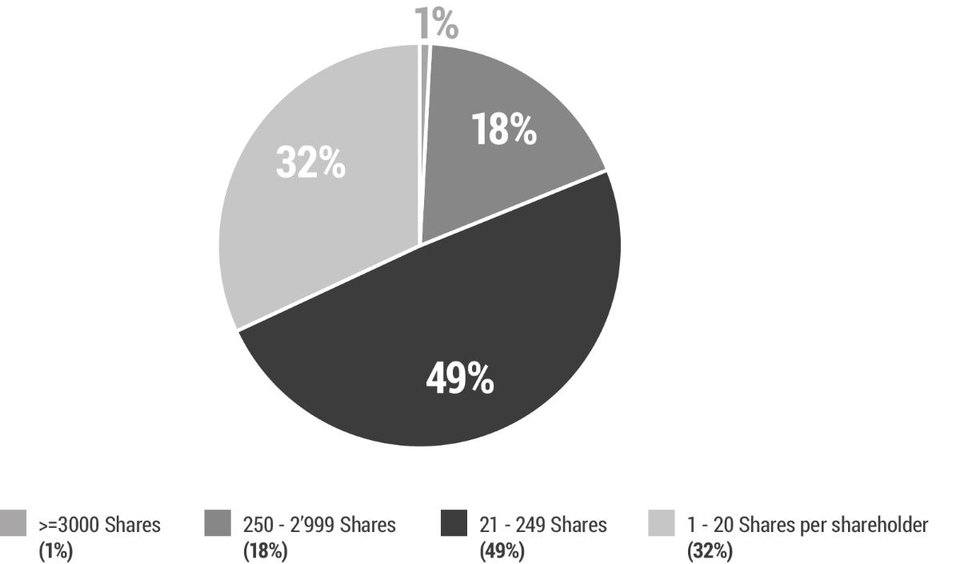
Shareholder structure (share of capital)
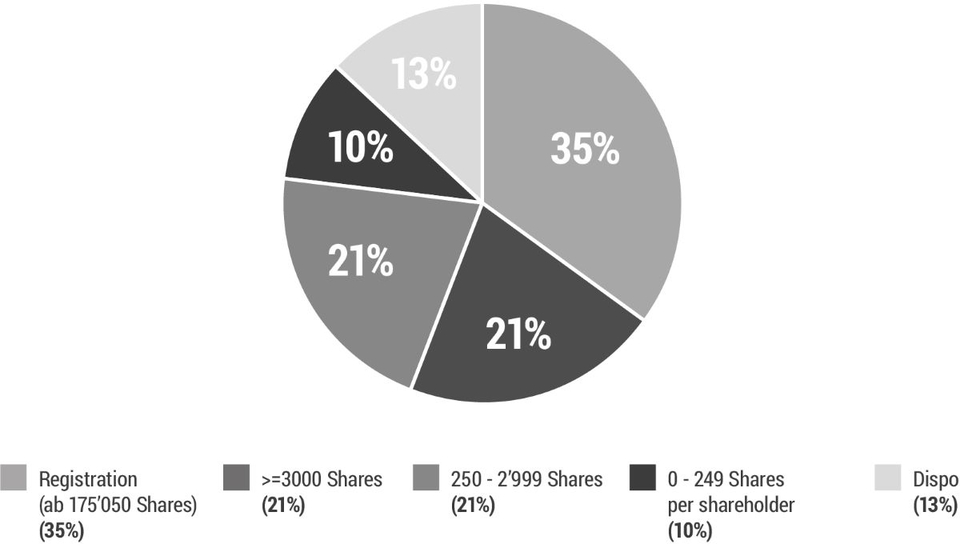
V-Cableway
The V-Cableway project is a joint venture of Jungfraubahn AG, Wengernalpbahn AG, Gondelbahn Grindelwald-Männlichen AG, Berner Oberland-Bahnen AG and Grindelwald Grund Infrastruktur AG. From a common terminal in Grindelwald Grund, a new tricable gondola "Eigerexpress” runs to the Eiger Glacier in 15 minutes and a ten-person gondola runs to Männlichen. The Grindelwald Terminal of the Bernese Oberland Railway gives the V-Cableway a connection to the national railway network. The route of the tricable gondola guarantees a unique view of the world-famous Eiger north face. The travel times to Jungfraujoch and the ski area will be significantly shortened by up to 47 minutes.
On 11 June 2018, construction work on the core elements of the V-Cableway was started. The official ground-breaking ceremony was held on 3 July 2018 in Grindelwald, where the new terminal and parking garage are being constructed. As a result of the ongoing optimal weather conditions, important construction progress was made, especially in the months of July to November 2018. The shell construction of the platform system for the Terminal Grindelwald station was completed at the end of the year. By the end of November, the prefabricated elements of the passenger underpass were installed. At the Grindelwald-Männlichen cableway and tricable gondola Eigerexpress stations, the expansion shafts have been completed and the shell of the new base stations was added. In addition, three of the seven columns have been completed on the route of the Eigerexpress. In order to provide the best possible support for the challenging construction work for the new tricable gondola in this area, a material cableway was built from Salzegg to the Eiger Glacier.
On 18 December 2018, the first spectacular heavy transport of the V-Cableway took place. A new transformer for the power supply of Grindelwald with a transport weight of 42 tonnes was delivered. The installation work began in the basement of the future Männlichen Railway valley station. After extensive cable work, this will be switched on in the spring of 2019. The old transformer station, which stands in the way of the parking garage, can then be dismantled.
The shell construction (floor slab and walls) for the connecting passage between the railway station and the cable cars for the north section of the terminal continued in winter. The erosion of the Eiger glacier for the extension of the station Jungfraubahn and the new construction of the Eigerexpress mountain station continued in spite of the cold and snow.
Impressions constructions sites V-Cableway
With the start of construction of the V-Cableway, the great economic significance of the project for the Jungfrau Region is immediately apparent. At the end of the year, a total of 220 workers (planners & construction workers) were working on the V-Cableway. Orders totalling CHF 100.5 million have already been granted to companies from the Bernese Oberland. This corresponds to 95% of the order amount in 2018. Of the 36 companies currently commissioned, 26 are from the region. The main target for 2019 will be the completion of the new Grindelwald-Männlichen cableway and the opening of the first part of the Grindelwald terminal as well as the Grindelwald public transport station on 14 December 2019. With the opening of the new Grindelwald-Männlichen cableway, our guests will enjoy the first-time savings with a reduction from 30 to 19 minutes. Other important project advancements in 2019 will be the completion of pillars 4 to 7 on the Eigerexpress route and the assembly of the valley station for the new tricable gondola. This will commence regular operation on 12 December 2020.
The marketing of the new railways is already in full swing. The remaining time is shown by the four publicly placed Tissot Countdown Clocks, which are counting down the days, hours and seconds to the opening.
The investments for the V-Cableway generation project amount to a total of CHF 470 million, of which CHF 320 million is borne by the Jungfrau Railway Group. These investments can be made through our own financial resources and bank loans in the amount of approximately CHF 60 million. To show the importance and scope of this project, some numbers are listed below. These relate to the completion of the entire project in December 2020.
Facts & Figures V-Cableway
| V-Cableway project with terminal and car park | Tricable gondola Eigerexpress | Gondelbahn Grindelwald-Männlichen | |
|---|---|---|---|
| Amount in m3 of built-in concrete | 40,000 m3 | ||
| Total excavation in m3 | 110,000 m3 | ||
| Number of tonnes of steel used | 310.2 tonnes | 328 tonnes | |
| Total weight of steel ropes | 700 tonnes | 124 tonnes | |
| Weight towing cable | 168 tonnes | ||
| Weight supporting cable | 532 tonnes | ||
| Total length of steel ropes | 41,324 m | 12,554 m | |
| Length towing cable | 2x 6,782 m | ||
| Length supporting cable | 4x 6,940 m |
Personnel and recognition
Management Board and Executive Board
At the 2018 Annual General Meeting, Dr Catrina Luchsinger Gähwiler was elected to the Management Board. She replaced Bruno Hofweber, who was no longer available for re-election. The chairman, the remaining four members of the Management Board and the composition of the remuneration committee were also confirmed by the AGM.
Since June 2017, the Executive Board has consisted of three members: Urs Kessler, CEO, Christoph Seiler, CFO, and Christoph Schläppi, Corporate Secretary. For the time being, the Management Board has decided not to add another member.
The information on the persons and compensation for the Management Board and Executive Board can be found in the remuneration report and the corporate governance section of this annual report.
Management of operational units
As of 1 January 2018, the organisational structure was formally adapted to the process organisation, which is process-oriented. The activity of the three business fields is described in the main processes of the process organisation. Several specialist and support departments support the added value in the business segments. The major value creation processes, i.e. the business units, are now assigned a management function in the organisational chart of the organisational structure:
- Markus Balmer, Top of Europe business segment
- Marco Luggen, Experience Mountains and Winter Sport segments
- Thomas Aebischer, Bernese Oberland Railways segment leader (partner company)
The segment managers in the organisation matrix have the role of ordering the services of the specialist and support departments. These are led by the following managers:
- Markus Balmer, Technology
- Patrizia Bickel, Corporate Communications
- Matthias Bütler, Marketing
- Dominik Liener, Infrastructure
- Reto Mettler, Gastronomy
- Andreas Piattini, Human Resources
- Christoph Seiler, Finance
- Urs Siegenthaler, IT
- Stefan Würgler, Operations
The site managers Werner Amacher, Martin Loosli, Stefan Wittwer and Nils von Allmen will continue their previous work in the same or expanded form within the new structures.
